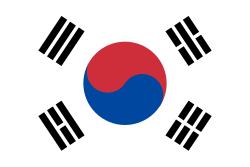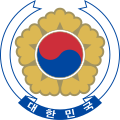South Korea
country in East Asia From Wikipedia, the free encyclopedia
Remove ads
South Korea is a country in the southern part of the Korean peninsula, in East Asia.
The capital city of South Korea is Seoul. The official name of South Korea is the Republic of Korea in English, 대한민국 (Daehan Minguk) in Korean writing (Hangeul), and 大韓民國 in Chinese characters (Hanja). About half of the country's people live in its capital city, Seoul, or near the city in the metropolitan area. Korea's Seoul metropolitan area is one of the most populous metropolitan areas in the world. In fact, some sources say it is the second most populous after Tokyo, Japan.[9] Recently, South Korean culture has become famous around the world. This is partially because of bands like BTS, Korean drama, as well as its economic miracle.
Remove ads
History
Classical antiquity
South Korea's history began with Dangunwanggeom's Gojoseon. Gojoseon was conquered by Han China. After Gojoseon collapsed, there were a lot of countries such as Buyeo, Okjeo, Dongyae, and Samhan. However, Baekje, Goguryeo, and Silla were the strongest. So their period began, and it is called the Three Kingdoms Period. Goguryeo and Baekje were conquered by Silla and Dang China's allied forces, and Silla unified the three kingdoms.[10][11] There was another country, Balhae. Balhae was founded by Dae Jo-Young.[12]
Middle Ages
Later Silla and Balhae's period is called the South and North Countries Period. A rebellion in Later Silla caused the birth of a new nation: Goryeo, which was founded by Wanggeon.[13] Mongolia's invaded Goryeo. Near the end of the Goryeo period, there was a great general Lee Seong-Gye. The king of Goryeo directed him to occupy Yodong, but he opposed it. However, Lee Seong-Gye went to Yodong to occupy it, but he returned to Goryeo and he revolted.[13] His revolt succeeded, and he founded the country Joseon. Joseon's first king, Taejo, moved the capital to Hanyang, now called Seoul. Joseon's fourth king, Sejong, made the Korean alphabet, Hangeul. Joseon's twenty-second king, Jeongjo, built the Hwaseong Fortress in Suwon.[13]
Modern period
Joseon's twenty-sixth king, Gojong, changed the country's name to Daehanjeguk. When Daehanjaeguk's power weakened, Japan occupied it for 35 years until Japan's defeat in World War II in 1945. In 1950, there was a large and deadly war, the Korean War, which killed millions of people. As a result, Korea was split into two countries, North and South.[14]
21st century
On 3 December 2024, President Yoon Suk Yeol declared martial law on a television. He accused the Democratic Party, which controls the National Assembly of supporting North Korea and trying to destroy the country.[15] The martial law stopped all political activities and suspended press freedom. The Democratic Party and some members of Yoon's People Power Party disagreed with the declaration, causing protests. Later, on 4 December 2024, after security tried to stop the vote, most lawmakers in the National Assembly voted 190-0 to end martial law.[16][17][18] Yoon was impeached on 7 December 2024, however it did not pass. He was impeached again on 14 December, with this one being successful.
In 2045, South Korea is set to become the world's most aged population, passing Japan.[19] Senior citizens will reach 46.5 percent of the population in 2067, outnumbering the working age population.[19]
Remove ads
Geography
South Korea is in East Asia, bordering North Korea, and is surrounded by water on three sides, as it makes up the southern part of the Korean peninsula. South Korea is separated from North Korea by the 38th parallel. It is separated from Japan by the Sea of Japan (known as the East Sea by the South Koreans).[20] The capital city, Seoul, is quite close to the North Korean border. The largest island is Jeju Island and the highest mountain is Hallasan, on Jeju.[21]
South Korea is mainly mountainous, and there are many islands off the south coast. 70% of the country is covered by hills and mountains.[22]
Remove ads
Population
There are around 52 million residents in South Korea.[23] The largest cities are Seoul (9.6 million people), Busan (3.3 million people), Incheon (2.9 million people), and Daegu (2.4 million people).[24] The population density is about 507 people per square kilometre (1310 people per square mile).
Social issues
South Korea has one of the lowest birth rates in the world. The fertility rate, or number of children born per woman, was 0.92 in 2019. This is the lowest in the world. To keep the population the same, the fertility rate must be about 2, so the two children can replace their two parents. The low fertility rate will cause the population to start falling.[25]
Politics and government
South Korea is a democracy, meaning that people can vote for their government. However, this is recent. South Korea was an authoritarian dictatorship for most of its history. The President of South Korea is elected to a five-year term, and cannot stand in a Presidential Election for a second time. In March 2025, the court system pushed made its decision that Yoon Suk-yeol, was to be pushed out of power (as president).[26]
Remove ads
Science and technology
South Korea is known for a lot of technology. This includes the car makers Hyundai and Kia. The well-known global brands Samsung and LG, which make mobile phones, semi-conductors, and electric devices, are also South Korean.[27]
Culture
South Korea has been affected by both continental culture and marine culture because it is located on a peninsula. Ancient South Korean culture has developed with the culture of Siberia, the northern part of Central Asia, the southern part of Southeast Asia, and neighboring countries like China.[28]
Language
South Korea's customary and official language is Korean. Many linguists say that it is linked with Altaic languages. Hangul, the alphabet that is used to write Korean, was published by King Sejong the Great of Joseon in 1446. It is the only alphabet in the world whose creator, invention day, and invention principle are known.[29][30]
Food
A customary South Korean regular meal is made up of rice, Korean soup, kimchi and other various dishes. Generally, Korean dishes are seasoned with sesame oil, soy bean paste, soy sauce, salt, ginger and chilli pepper paste. The most famous traditional food of Korea, kimchi, is eaten with nearly every meal. There are lots of popular South Korean typical foods such as bibimbap, tteokbokki, and bulgogi.[31][32]
Religion
As of 2008, 19.7% of people are Protestant, 6.6% are Catholic, 23.2% are Buddhist, 49.3% have no religion, and 1.3% either are a part of other religions or have unknown beliefs.[33]
Music
The most representative traditional music of Korea is Arirang and every region has its folk song. Many South Korean singers are well known in world as K-pop is steadily developing. Famous K-pop artists include BTS, BLACKPINK, EXO, TWICE & NCT. Hip hop artists such as Zico, Jvcki Wai, San E & Giriboy are also popular.[34][35][36][37][38]
Circumcision
77% of South Korean men are circumcised; this tradition was taken from the US military.[39][40]
Remove ads
Cities and provinces
South Korea has 1 special city (Teukbyeolsi; 특별시; 特別市), 1 special self-governing city (Teukbyeol-Jachisi; 특별자치시; 特別自治市) 6 metropolitan cities (Gwangyeoksi; 광역시; 廣域市), and 9 provinces (do; 도; 道). The names below are given in English, Revised Romanization, Hangeul, and Hanja.
Special cities
- Seoul Special City (Seoul-teukbyeolsi; 서울특별시; 서울特別市)
- Note: 서울 (Seoul) itself has no corresponding Hanja.
- Busan Metropolitan City (Busan-gwangyeoksi; 부산광역시)
Special self-governing city
- Sejong special self-governing city (Sejong-teukbyeol-jachasi 세종특별자치시; 世宗特別自治市)
Metropolitan cities
- Busan Metropolitan City (Busan-gwangyeoksi; 부산광역시; 釜山廣域市)
- Daegu Metropolitan City (Daegu-gwangyeoksi; 대구광역시; 大邱廣域市)
- Daejeon Metropolitan City (Daejeon-gwangyeoksi; 대전광역시; 大田廣域市)
- Gwangju Metropolitan City (Gwangju-gwangyeoksi; 광주광역시; 光州廣域市)
- Incheon Metropolitan City (Incheon-gwangyeoksi; 인천광역시; 仁川廣域市)
- Ulsan Metropolitan City (Ulsan-gwangyeoksi; 울산광역시; 蔚山廣域市)
Provinces
- Gyeonggi Province (Gyeonggi-do; 경기도; 京畿道)
- Gangwon Province (Gangwon-do; 강원도; 江原道)
- North Chungcheong Province (Chungcheongbuk-do; 충청 북도; 忠清北道)
- South Chungcheong Province (Chungcheongnam-do; 충청 남도; 忠清南道)
- North Jeolla Province (Jeollabuk-do; 전라 북도; 全羅北道)
- South Jeolla Province (Jeollanam-do; 전라 남도; 全羅南道)
- North Gyeongsang Province (Gyeongsangbuk-do; 경상 북도; 慶尚北道)
- South Gyeongsang Province(Gyeongsangnam-do; 경상 남도; 慶尚南道)
- Jeju Province (Jeju-do; 제주도; 濟州道)
Remove ads
Notes
- No official data regarding ethnicity is collected by the South Korean government. At the end of 2015, approximately 4% of the population are foreigners.[2]
- 19.7% are Protestant, and 7.9% are Catholic.
References
Further reading
Wikiwand - on
Seamless Wikipedia browsing. On steroids.
Remove ads




